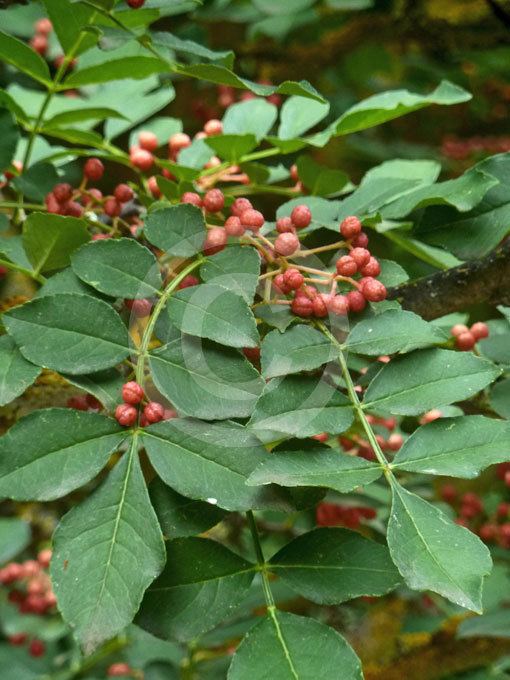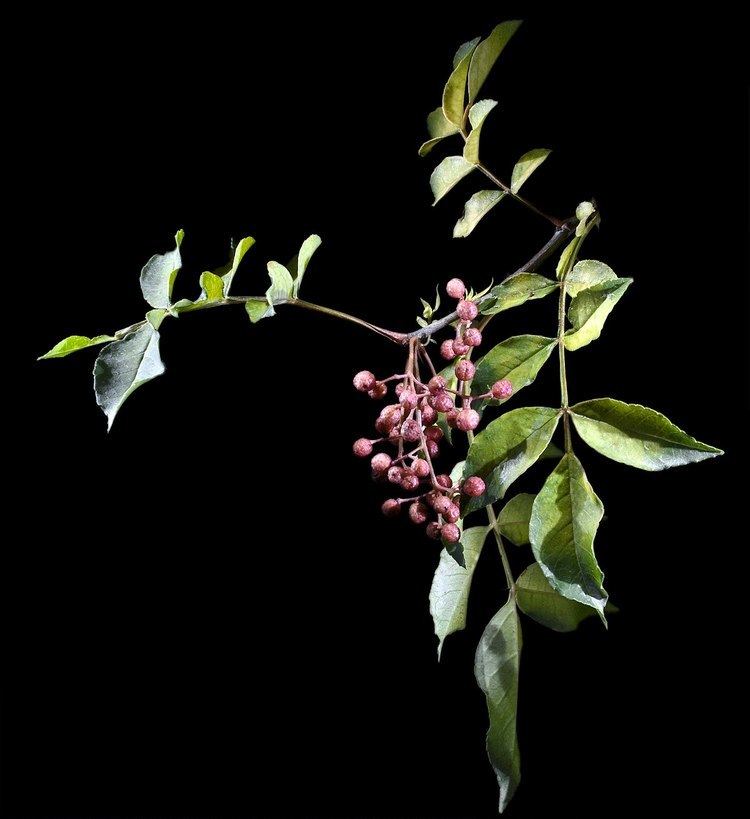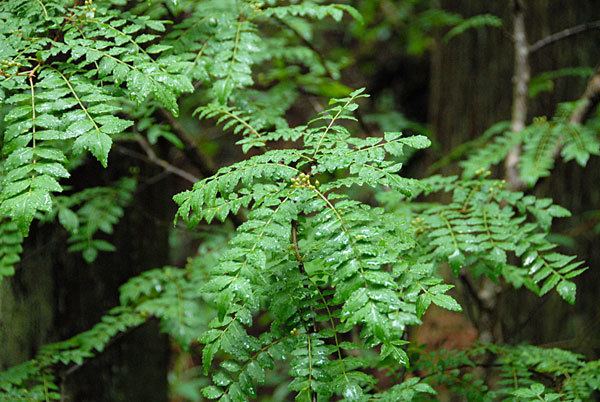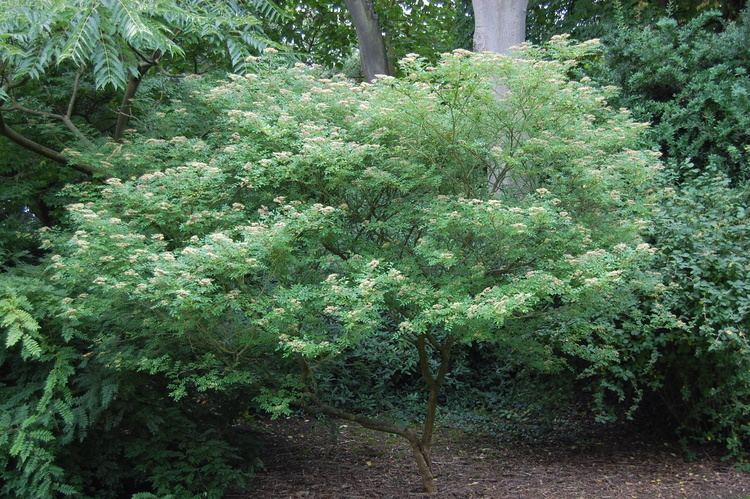Scientific name Zanthoxylum piperitum Rank Species | Genus Zanthoxylum Higher classification Zanthoxylum | |
Similar Zanthoxylum, Citrus junos, Shiso, Black pepper, Wasabi | ||
Bons i zanthoxylum piperitum ref zxp02
Zanthoxylum piperitum, called Japanese pepper, chopi, or Korean pepper in English and sanshō (Japanese: 山椒) in Japanese, is a deciduous aromatic spiny shrub or small tree, belonging to the Rutaceae (citrus and rue) family. Natural range spans from Hokkaido to Kyushu in Japan, southern parts of the Korean peninsula, and Chinese mainland. The related Z. schinifolium (Japanese: イヌザンショウ pron. inuzanshō, lit., "dog sansho") occurs as far south as Yakushima, attaining a height of 3 meters.
Contents
- Bons i zanthoxylum piperitum ref zxp02
- Zanthoxylum piperitum
- Names
- Description
- Japan
- Korea
- Craft
- China
- Piscary
- References

It is an important host plant for several Japan indigenous swallowtail butterfly species, including the common Papilio xuthus.
Zanthoxylum piperitum
Names

In Japanese, the name sanshō(山椒) refers to Z. piperitum, and the name inuzanshō(犬山椒, "dog sanshō") refers to Z. schinifolium. In Korean, the cognate name sancho(산초) refers to Z. schinifolium, and the name gaesancho(개산초, "dog sancho") refers to Z. armatum. In Korea, Z. piperitum is called chopi(초피). In Japan, Z. armatum var. subtrifoliatum, which is a variety of Z. armatum, is called fuyuzanshō(冬山椒, "winter sanshō").
Description

The tree blooms in April to May, forming axillary flower clusters, about 5mm, and yellow-green in color. It is dioecious, and the flowers of the male plant can be consumed as hana-sanshō, while the female flowers yield berries or peppercorns of about 5mm.
For commercial harvesting, thornless varieties called the Asakura sansho are widely cultivated. Around September to October, the berries turn scarlet and burst, scattering the black seeds within.

The branch grows pairs of sharp thorns, and has odd-pinnately compound leaves, alternately arranged, with 5〜9 pairs of ovate leaflets having crenate (slightly serrated) margins.
Japan
The pulverized mature fruits ("peppercorns" or "berries") known as "Japanese pepper" or kona-zanshō (Japanese: 粉ざんしょう) are the standard spice for sprinkling on the broiled eel (kabayaki unagi) dish. It is also one of the seven main ingredients of the blended spice called shichimi, which also contains red chili peppers.
The finely ground Japanese pepper, kona-zanshō, is nowadays usually sold in sealed packets, and individual serving sizes are included inside heat-and-serve broiled eel packages. While red chili pepper is never used on eel, otherwise, in many usages, the Japanese red chili pepper, or the shichimi blend of peppers can be used in lieu of Japanese pepper alone, according to taste: e.g., to flavor miso soup, various noodles in broth or dipped in tsuyu, Japanese pickles (tsukemono), teriyaki or fried chicken.
Young leaves and shoots, pronounced ki no mé or ko no mé (Japanese: 木の芽 lit. "tree-bud") herald the spring season, and often garnish grilled fish and soups. They have a distinctive flavor and is not to the liking of everyone. It is a customary ritual to put a leaf between cupped hands, and clap the hands with a popping sound, this supposedly serving to bring out the aroma. The young leaves are crushed and blended with miso using pestle and mortar (suribachi and surikogi) to make a paste, a pesto sauce of sorts, and then used to make various aemono (or "tossed salad", for lack of a better word). The stereotypical main ingredient for the resultant kinome-ae is the fresh harvest of bamboo shoots, but the sauce may be tossed (or delicately "folded", to use a pastrymaking term) into sashimi, clams, squid or other vegetable such as tara-no-me (Aralia elata shoots).
The immature green berries, blanched and salted, are called ao-zanshō (lit. "green sansho"). The berries are traditionally simmered into dark-brown tsukudani, but nowadays are also available as shoyu-zuke, which is just steeped in soy sauce. The berries are also cooked with small fry fish and flavored with soy sauce (chirimen jako), a specialty item of Kyoto, since its Mount Kurama outskirts is a renowned growing area of the Japanese pepper.
The thornless variety Asakura sansho derives its name from its place of origin, the Asakura district in the now defunct Yokacho, integrated into Yabu, Hyōgo.
Wakayama Prefecture boasts 80% of domestic production. Aridagawa, Wakayama procuces a specialty variety called budō sanshō ("grape sansho"), which bears large fruits and clusters, rather like a bunch of grapes.
Confections In central and northeastern Japan, a non-sticky rice-cake type confection called goheimochi, which is basted with miso-based paste and grilled, sometimes uses the Japanese pepper as flavor additive to the miso. Also being marketed are sansho flavored arare (rice crackers), snack foods, and sweet sansho-mochi.
Korea
The fruit of Zanthoxylum piperitum, chopi, is called by many names including jepi, jenpi, jipi, jopi in southern parts of Korea, where the plant is extensively cultivated and consumed. In Southern Korean cuisine, chopi is used as a condiment served with varieties of food such as chueotang(pond loach stew), maeuntang(spicy fish stew), and hoe(raw fish). Chopi leaves are eaten pickled as jangajji, pan-fried to make buchimgae(Korean pancake), or deep-fried as fritters.
Condiments
Ingredients
Dishes
Craft
In Japan, the thick wood of the tree is traditionally made into a gnarled and rough-hewn wooden pestle, to use with suribachi.
China
The husks are used medicinally. In traditional Chinese medicine it finds uses similar to the hua jiao or Sichuan pepper
Japan
In Japanese pharmaceuticals, the mature husks with seeds removed are considered the crude medicine form of sanshō. It is an ingredient in bitter tincture, and the toso wine served ceremonially. The pungent taste derives from sanshool and sanshoamide. It also contains aromatic oils geraniol, dipentene, citral, etc.
Piscary
In Southern parts of Korea, the fruit is traditionally used in fishing. Being poisonous to small fishes, a few fruits dropped in a pond make the fishes float shortly.
